Learn more about what is a stable gold coin and what are the benefits and advantages of a stable gold coin
What is GOLD Stablecoin?
Cryptocurrency like Bitcoin and Ethereum are known for their volatility.
To overcome the wild price changes of various blockchain assets, cryptocurrency or tokens known as "stablecoin" have been developed.
Gold Stablecoin is a cryptocurrency or token that is designed to have a stable value and has the same price as the traditional gold price For example, if we have 1 Stablecoin Gold that will be worth 1 GRAM of Physical Gold.
Gold and Bitcoin
Gold has fascinated mankind for thousands of years. So far, more than 190,000 tons of the precious metal have been mined.[2] How much is still underground remains unknown. One thing is clear, however: The extractable quantity is finite and subject to diminishing returns. Similarly, the number of bitcoins that can be mined is limited: The mysterious inventor of Bitcoin has set the maximum amount to 21 million coins.[3] Unlike fiat money, gold and Bitcoin cannot be created by central banks at will in response to demand shocks. While the average annual growth rate of the gold supply is around 1.7 % with a rather small standard deviation,[4] Bitcoin’s inflation rate is currently 3.69 % and on a downward trajectory.[5] As mentioned in last year’s In Gold We Trust report, the supply of newly mined bitcoins follows a preprogrammed, transparent, and predictable schedule, which remains unaffected by fluctuations in demand.[6] Their inelastic supply makes the prices of gold and Bitcoin dependent on their demand.
Overall, the supply trajectories of Bitcoin and gold show that Bitcoin is expected to have a lower inflation rate by 2021. Every 210,000 blocks, the reward the miners receive per block is halved. This roughly corresponds to a four-year “half-life.” Observers pay very close attention to the schedule, because the so-called “halving” is regarded as an important indicator of price movement. There is only little experience so far, since there have been only two such “halvings.” But they show that the price has always risen in the months before the actual event. Specifically, the Bitcoin price found its bottom in the first bear market that came 378 days before the first halving and again in the second bear market, 539 days before the second halving.[7]
This equals an average of 458 days, and we are currently approximately 350 days from the next halving, which will probably take place towards the end of May 2020. If the pattern observed so far is confirmed, the bottom should have occurred somewhere between December 2018 and May 2019.
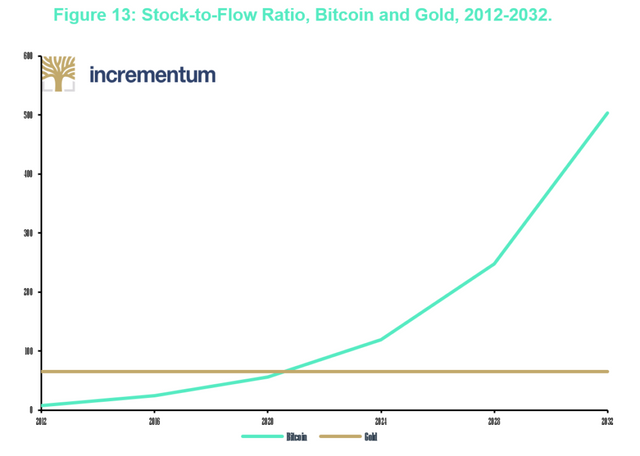
When we compare the supply of gold to the supply of Bitcoin, we notice that both are being mined, albeit in their own particular ways. Gold can be found in soil, rivers, and rocks all over the world, regardless of borders. Similarly, independently of their location, Bitcoin miners receive a reward for providing the network with computing power to verify and settle transactions. The main difference when it comes to mining is that mining is what secures the Bitcoin network and the price of Bitcoin on the market. In contrast, gold mining does not secure the price of gold. Therefore, we would like to make the subtle distinction that Bitcoin is not a bearer instrument in the same sense that gold is. Paying with gold requires absolutely no dependence on a network for settlement. However, Bitcoin transactions can take hours to settle; and trusting the software, hardware, and internet that support Bitcoin is a type of counterparty risk even though the “party” is not human.
To make Bitcoin and gold even more scarce, a certain amount of Bitcoin and gold becomes unusable every year. Previously, gold was used in quantities that made smelting and recovery cost-effective and common. For example, the gold in your mother’s necklace may well have in it metal mined by the Romans, then used by the Tudors, etc. Now we see gold used in tiny amounts in high-tech goods, amounts that may not be cost-effective to salvage for a long time. The British Geological Survey estimates that around 12% of current world gold production is being lost for this reason.[8]This means gold is being consumed in an absolute sense for the first time in history. Again, this is similar to Bitcoin’s annual loss of coins that are unspendable due to lost private keys and fat-finger mistakes while typing cumbersome recipient addresses. Two different cryptocurrency researchers, Chainanalysis and Unchained Capital, have created an upper bound of 3.8 million for the total number of Bitcoins lost.[9] Overall, the supply trajectories of Bitcoin and gold show that Bitcoin is expected to have a lower inflation rate by 2021.[10]
Does Bitcoin Hurt Gold?
Since many young investors consider Bitcoin to be digital gold with a payment option, some may suspect that the demand for gold is adversely affected by the success of cryptocurrencies. As of yet, the correlation between gold and Bitcoin returns is still low and slightly positive, indicating that the demand for gold is not adversely affected by cryptocurrencies.
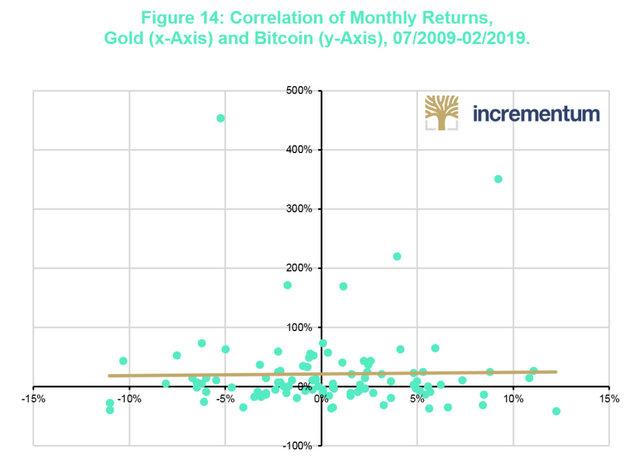
This secure demand strength of gold is due to the unique advantages it has over Bitcoin. First, gold is far less volatile than cryptocurrencies and will remain so for the time being. In 2017, Bitcoin was about 15 times more volatile than gold. In addition, gold is much more liquid. On average, USD 2.5bn in Bitcoin is traded daily.[11] This amounts to just 1% of the total gold market: The daily trading volume of gold is around USD 250bn. Furthermore, gold trades in regulated and well-established venues and has long been accepted by institutional investors as an investment alternative. This is not the case for cryptocurrencies.[12]
Leveraging Gold’s Stability
The US dollar’s hegemony is under increasing pressure from China and Russia, as US national debt reaches record highs. Instead of returning to a gold standard in support of a fiat currency, the 21st century could witness the emergence of a gold standard involving a cryptocurrency.
The notion of a monetary system based on a cryptocurrency may be surprising, given the fact that cryptocurrencies are the most volatile asset class. Many Bitcoin holders have experienced a ride from USD 1,000 right up to USD 20,000, and then steadily back down, culminating in a long, choppy sideways market followed by the recent rally to USD 8,000. Enter stablecoins. Stablecoins promise to offer all of Bitcoin’s benefits while fixing the problem of volatility.
While the decentralized and independent nature of their supply makes gold and Bitcoin good stores of value, there are major differences with respect to other monetary features. Following Dobeck and Elliott[13] and Berentsen and Schär[14], the next table gives a quick overview.[15]
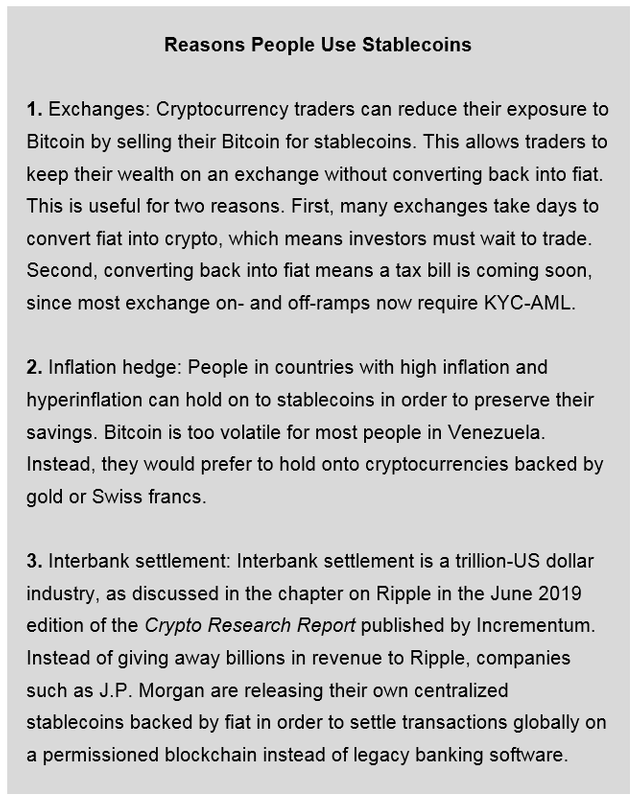
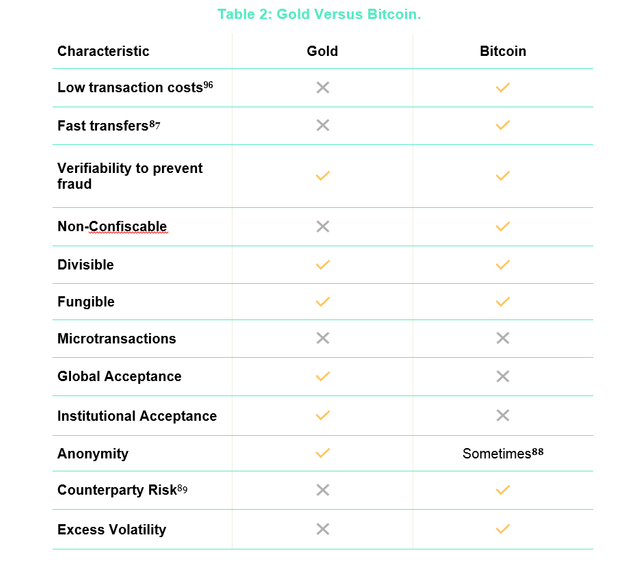
However, the promise is most likely to be optimistic, as promises often are in the cryptocurrency space. For several decades, countries around the world have tried to peg their exchange rates to other more stable currencies. Not a single fixed peg has lasted in the long run.
Take for example the European Exchange Rate Mechanism (ERM), which attempted to keep the plethora of European currencies within a narrow band of each other during the ‘80s and ‘90s. Since the UK could not keep their print presses turned off, George Soros and other speculators were able to mount a speculative attack and profit from breaking the peg. This is because whenever a currency holds fractional reserves, arbitrage opportunities arise between it and other currencies. Therefore, stablecoins that are not fully backed are trading off between stability in the short run and blow-up risk in the long run, because keeping a fixed peg without investing in the underlying asset makes the peg fragile to black swan events.
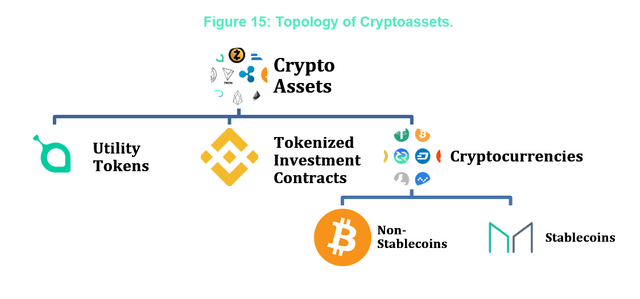
However, Bitcoin is volatile, and many cryptocurrency users are now demanding stability. To meet this demand, the new stablecoins are combining the advantages of gold and Bitcoin. Gold-backed stablecoins are similar to gold ETFs. For example, the most famous gold ETF, SPDR Gold Shares (GLD), is a fund that buys physical gold and divides the ownership of it into shares.
In theory, gold-backed cryptocurrencies are supposed to work the same way. However, there are currently no cryptocurrency exchanges that are licensed to trade tokenized ETFs. Even if regulators eventually approve an application for such an exchange, they will require KYC/AML on each transaction.[19] This begs the question: How is a centralized gold-backed stablecoin any better than a gold ETF? We have still not found a suitable answer to this question. In fact, the solution seems inferior at first glance, because investors still have to safely protect the private keys that control the gold-backed stablecoins, and if the tokens are traded on a public blockchain like Ethereum, then the coins will be subject to volatile and increasing transaction fees when they send and receive the gold tokens. Then there are all of the problems associated with public blockchains, such as latency, lack of scalability, and security.
As shown on the next figure, there are three main types of collateralized stablecoins: fiat, commodity, and crypto. Gold-backed cryptocurrencies are considered to be centralized “off-chain-backed coins” because they generate value by a counterparty’s depositing gold, gold certificates, or other gold-related securities into a vault. Similar to fiat-collateralized coins like the infamous Tether, gold-backed cryptocurrencies are supposed to be listed on cryptocurrency exchanges so that gold positions can be opened and closed within seconds by retail and professional investors alike.
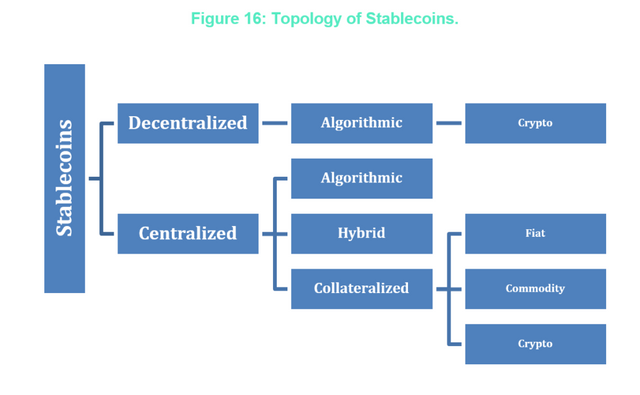
Gold-Backed Stablecoins
Over 50 cryptocurrencies are somehow backed to gold. The next section summarizes just a handful of the gold-backed projects. The projects selected were drawn from responses to an official @CryptoManagers tweet on Twitter. We asked our followers what coins they wanted to learn more about. We also selected a few coins from the German-speaking countries, including Vaultoro, Novem, and AgAu. Finally, we have included an update on the gold-backed tokens that we covered last year.[20]
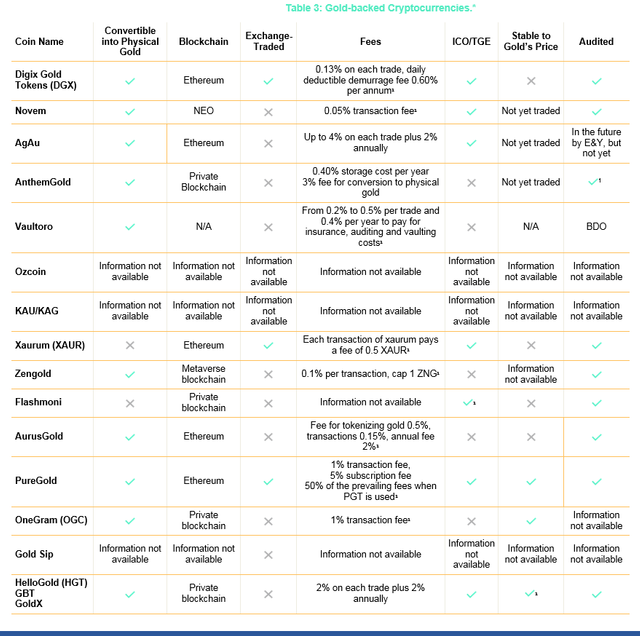
Writing : https://bitcointalk.org/index.php?action=profile;u=2515973
0x8e3a1a75B1F4c4Fe56115c071b076CCcD967f432